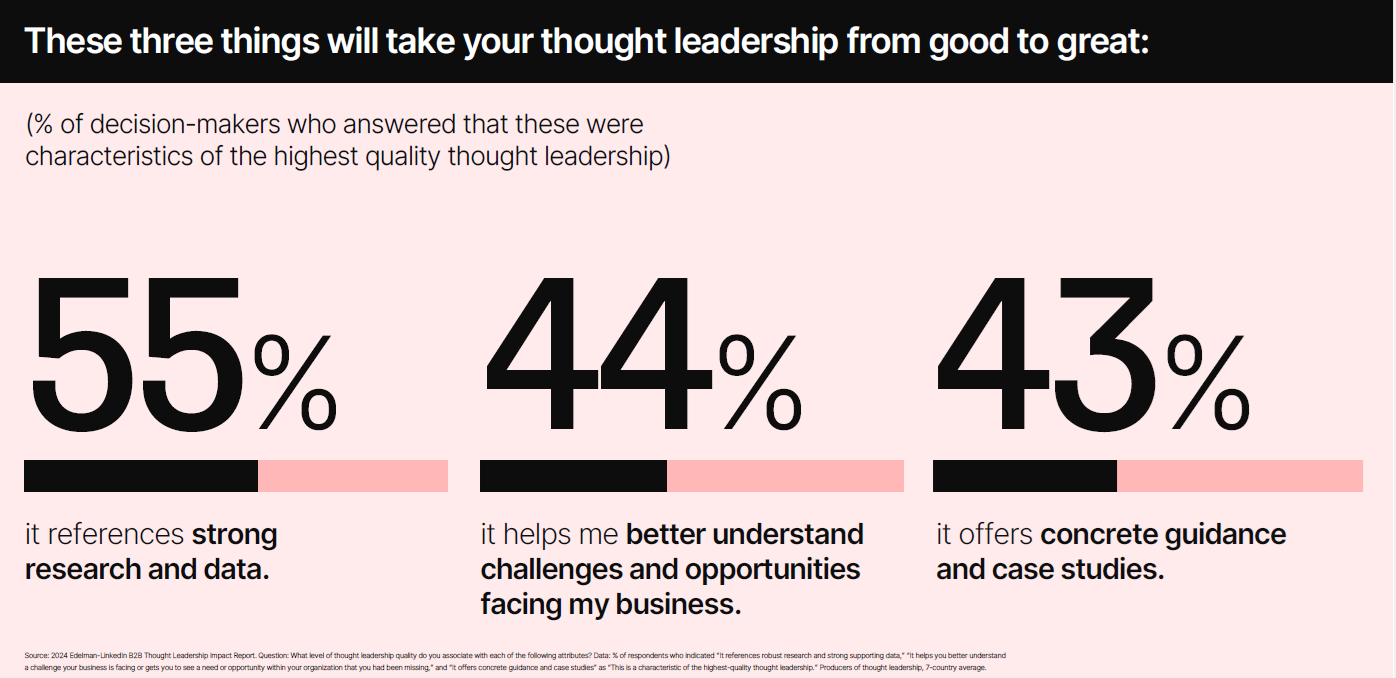By the Numbers: This is the impact thought leadership has on prospects — and current customers
New data from Edelman and LinkedIn reveals that good thought leadership is vital for B2B sales and retention.

Thought leadership content is more trusted by decision makers than marketing materials or product sheets, according to new data from research conducted by Edelman and LinkedIn. A huge 75% of decision-makers, including members of the C-suite, say that thought leadership has prompted them to research products or services they had not previously considered, according to the data presented in “Reaching Beyond the Ready: Thought Leadership’s Impact on Engaging Out-of-Market B2B Buyers.”
But perhaps most surprising is that thought leadership is critical not only to attracting and retaining new customers, but also to helping competitors steal one another’s existing business.
The survey found that 70% of C-suite executives said that thought leadership had led them to reconsider their current vendor relationship. About half (54%) said thought leadership made them realize other vendors might better understand their challenges and needs.
“Particularly for companies that are involved in pretty high-value — high-monetary-value relationships in complex industries, customers really need to be reassured that they are getting state-of-the art in terms of thinking, in terms of capabilities,” Joe Kingsbury, global chair of Edelman Business Marketing, told PR Daily in an interview. “The companies that generally fit that scenario really need to be reminding their customers consistently that we are the kind of company that can keep you ahead of the curve and help you anticipate challenges and can help you solve some of your most complex problems.”
In addition to helping steal customers from other organizations or keep those you have close, Kingsbury said Edelman’s customers find that thought leadership can help them cross-sell or upsell existing customers, particularly for lesser-known offerings.
What makes great thought leadership?
We’ve all seen tepid, lukewarm takes masquerading as thought leadership. Those aren’t going to move the needle.
What does, according to the survey, is data, showing understanding of challenges and concrete case studies.

“There really needs to be some kind of rigor and analysis,” Kingsbury explained. “That doesn’t mean that there’s not room for opinion — absolutely, there is room for provocative opinion — ut also that it’s on a foundation of some interesting data.”
Who delivers the thought leadership matters too, but not in the way you might think. Sixty-two percent of respondents said high-quality thought leadership is produced by a prominent or high-quality expert. But that doesn’t necessarily mean your CEO, Kingsbury cautioned.
“That’s one that I think has been really interesting for our clients, because a lot of times companies will default to, ‘hey, this should be the CEO.’ But really, what they should be thinking is ‘well, for this particular topic, who would actually be viewed as the most credible expert?’”
That may be the CEO or it could be someone else. It’s the credibility that matters more than the title.
The eternal problem of measurement
The people and organizations who create thought leadership do so to increase positive sentiment among potential clients (55%), get leads to reach out for more information (48%) and get potential clients to consider their services (40%).
But as in so many areas of PR, measurement remains a constant struggle in thought leadership. A full 20% of survey respondents said they had no systems in place for measuring the efficacy of thought leadership, and 42% measure that effectiveness purely through looking at website and social media traffic.
Fewer than one in three respondents (29%) say they can trace sales back to specific thought leadership pieces.
Kingsbury attributes this lack of measurement to the complexities and multitude of factors that go into closing a big B2B deal. But not understanding the efficacy of thought leadership can cause a destructive feedback loop in the long run.
“The bottom line is, when companies and B2B marketers don’t have the ability to link their thought leadership and their content publishing back to some kind of business impact, it creates this sort of negative cycle, because they don’t have an ROI story,” Kingsbury explained. “And then as a result, they have a difficult time getting the resources that they need; they have a difficult time getting internal engagement with senior subject matter experts and others. And that typically is going to lead to low-quality content. The low-quality content doesn’t do a good job actually having an effect on your potential customers. And then the cycle just repeats itself.”
Indeed, this is borne out in the data: While 86% of decision-makers say they’re “somewhat” or “very” likely to invite creators of consistent, quality thought leadership to participate in RFPs, only 38% of the people who create that content expect the same result.
“B2B marketing leaders really need to figure out for their own company,” Kingsbury said. “How does thought leadership content contribute to getting customers into the pipeline, and then progressing them through so that they can actually explain the value of doing it?”
Allison Carter is editor-in-chief of PR Daily. Follow her on Twitter or LinkedIn.







